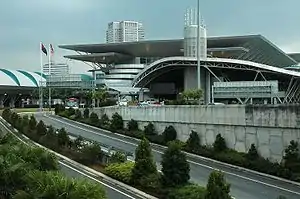Border checkpoint
A border checkpoint is a place, generally between two countries, where travelers or goods are inspected. Authorization often is required to enter a country through its borders. Access-controlled borders often have a limited number of checkpoints where they can be crossed without legal sanctions. Arrangements or treaties may be formed to allow or mandate less restrained crossings (e.g. the Schengen Agreement). Land border checkpoints (land ports of entry) can be contrasted with the customs and immigration facilities at seaports, international airports, and other ports of entry.


Checkpoints generally serve two purposes:
- To prevent entrance of individuals who are either undesirable (e.g. criminals or others who pose threats) or simply unauthorized to enter.
- To prevent entrance of goods that are illegal or subject to restriction, or to collect tariffs.
Checkpoints are usually manned by a uniformed service (sometimes referred to as customs service or border patrol agents).
In some countries (e.g. China) there are border checkpoints for both those entering and those exiting the country, while in others (e.g. U.S. and Canada), there are border checkpoints only when entering the country. (There are also United States Border Patrol interior checkpoints.)
Definitions in European Union (Schengen) law

The Schengen Borders Code, which forms part of the law of the European Union, defines some terms as follows (particularities with respect to the EU are left out, in order to emphasize general usability of those definitions):[3]
- "Border crossing point" means any crossing point authorized by the competent authorities for the crossing of external borders (Article 2 sec. 8 of the Schengen Borders Code);
- "Border control" means the activity carried out at a border, [...] in response exclusively to an intention to cross or the act of crossing that border, regardless of any other consideration, consisting of border checks and border surveillance (Article 2 sec. 9 of the Schengen Borders Code);
- "Border checks" means the checks carried out at border crossing points, to ensure that persons, including their means of transport and the objects in their possession, may be authorised to enter the territory [...] or authorised to leave it (Article 2 sec. 10 of the Schengen Borders Code);
- "Border surveillance" means the surveillance of borders between border crossing points and the surveillance of border crossing points outside the fixed opening hours, in order to prevent persons from circumventing border checks (Article 2 sec. 10 of the Schengen Borders Code).
- "Second line check" means a further check which may be carried out in a special location away from the location at which all persons are checked (first line)
These definitions mean that a place where a road crosses an internal Schengen border is legally not a "border crossing point".
Busiest checkpoints in the world
Land
This is a list of the busiest land border checkpoints in the world, handling more than 35 million travelers in both directions annually. These travelers (or individual crossings) comprise pedestrians, drivers and vehicle passengers. International border checkpoints are in green.
Notes:
- As the United States do not have border checkpoints for outgoing traffic, incoming traffic figures are doubled to give a fair comparison. The port of entry is paired with the respective Mexican port of entry. See detailed notes under reference column below.
- Explanation on the exclusion of El Paso Port of Entry from the list.[4]
| Rank | Border checkpoints | Annual Travelers | Reference | |||
|---|---|---|---|---|---|---|
| 1 | Gongbei Port | Posto Fronteiriço das Portas do Cerco | 134,000,000 | [5] (2018). | ||
| 2 | Sultan Iskandar Building | Woodlands Checkpoint | 127,750,000 | [2] (2012). Based on reported daily average. | ||
| 3 | Luohu Port | Lo Wu Control Point | 81,707,959 | [6] (2017). | ||
| 4 | Puerto Fronterizo El Chaparral | San Ysidro Port of Entry | 69,300,000 | [7] (2018). See note.[8] | ||
| 5 | Futian Port | Lok Ma Chau Spur Line Control Point | 59,464,480 | [6] (2017). | ||
| 6 | Shenzhen Bay Port | Shenzhen Bay Control Point | 45,118,797 | [6] (2017). | ||
| 7 | Huanggang Port | Lok Ma Chau Control Point | 37,059,848 | [6] (2017). | ||
| 8 | Puerto Fronterizo Mesa de Otay | Otay Mesa Port of Entry | 35,400,000 | [7] (2018). See note.[9] | ||
Air
This is a list of the busiest airports in the world, by international passenger traffic, as of 2018. Airports serving international passengers are effectively checkpoints, and have the proper customs, immigration and quarantine facilities. Airports Council International's (January–December) preliminary figures are as follows.[10]
| Rank | Airport | Annual Passengers | |
|---|---|---|---|
| 1 | Dubai International Airport | 88,885,367 | |
| 2 | London Heathrow Airport | 75,306,939 | |
| 3 | Hong Kong International Airport | 74,360,976 | |
| 4 | Amsterdam Airport Schiphol | 70,956,258 | |
| 5 | Seoul Incheon International Airport | 67,676,147 | |
| 6 | Paris-Charles de Gaulle Airport | 66,383,494 | |
| 7 | Singapore Changi Airport | 64,890,000 | |
| 8 | Frankfurt Airport | 61,774,663 | |
| 9 | Suvarnabhumi Airport | 50,868,846 | |
| 10 | Atatürk International Airport | 48,978,770 | |
Sea
This is a list of the busiest seaports in the world, with proper customs, immigration and quarantine facilities to be deemed as maritime checkpoints. Although figures simply represent total passenger traffic, most (if not, all) of the passengers served at these ports are bound for other countries and have to pass through checkpoint (i.e. the port is not a domestic one). This list only includes ports that handle more than 4 million passengers annually.
Note:
- The four passenger ports in China, Hong Kong and Macau in this list operate services to and from each other. These passenger ports are effectively checkpoints, as they have the proper customs, immigration and quarantine facilities.
| Rank | Port | Annual Passengers | Reference | |
|---|---|---|---|---|
| 1 | Taipa Ferry Terminal | 24,000,000 | [11] (2017). Based on five-year total. | |
| 2 | Hong Kong–Macau Ferry Terminal | 17,317,037 | [6] (2017). | |
| 3 | Outer Harbour Ferry Terminal | 15,000,000 | [12] (2013). | |
| 4 | Port of Helsinki | 12,300,000 | [13] (2017). | |
| 5 | Port of Dover | 11,700,000 | [14] (2017). | |
| 6 | Hong Kong-China Ferry Terminal | 7,074,940 | [6] (2017). | |
| 7 | PortMiami | 4,800,000 | [15] (2017). | |
| 8 | Port Canaveral | 4,500,000 | [16] (2016). | |
Gallery
 United States–Mexico border checkpoint at Nogales, Arizona.
United States–Mexico border checkpoint at Nogales, Arizona.

.jpg.webp)
 The Pont Saint-Ludovic / Ponte San Ludovico border checkpoint between Menton, France and Ventimiglia, Italy (both countries are part of the Schengen Area)
The Pont Saint-Ludovic / Ponte San Ludovico border checkpoint between Menton, France and Ventimiglia, Italy (both countries are part of the Schengen Area) Looking into Austria from Liechtenstein, with a joint border station. Since Liechtenstein joined the Schengen Area in 2011, this border station is for customs formalities only.
Looking into Austria from Liechtenstein, with a joint border station. Since Liechtenstein joined the Schengen Area in 2011, this border station is for customs formalities only. Nekhoteevka customs on the Russia-Ukraine border.
Nekhoteevka customs on the Russia-Ukraine border.
 The former checkpoint in Johor Bahru, Malaysia at the Johor–Singapore Causeway. It was replaced by the much larger Sultan Iskandar Building 1 km further inland in 2008.
The former checkpoint in Johor Bahru, Malaysia at the Johor–Singapore Causeway. It was replaced by the much larger Sultan Iskandar Building 1 km further inland in 2008.
 Posto Fronteiriço das Portas do Cerco on the Macanese side of the Zhuhai–Macau border.
Posto Fronteiriço das Portas do Cerco on the Macanese side of the Zhuhai–Macau border. The former customs and immigration station along the Canada–United States border at Noyes, Minnesota, built in 1931, one of the earliest purpose-built border stations in the United States and listed on the National Register of Historic Places.
The former customs and immigration station along the Canada–United States border at Noyes, Minnesota, built in 1931, one of the earliest purpose-built border stations in the United States and listed on the National Register of Historic Places.
References
- "Clearing the Causeway". 2018-06-09. Retrieved 2019-02-07.
- Lim, Yan Liang (2013-10-13). "A Look at Woodlands Checkpoint". The Straits Times. Retrieved 2019-06-13.
- "Regulation (EC) No 562/2006 of the European Parliament and of the Council of 15 March 2006 establishing a Community Code on the rules governing the movement of persons across borders (Schengen Borders Code)". 2006-04-13. Retrieved 2007-11-25.
- El Paso Port of Entry consists of six separate border checkpoints along the Texas-Chihuahua border, according to the Texas Comptroller of Public Accounts website, that handles 30,457,621 northbound individual crossings in 2018 as listed in a workbook by the USDOT, which works out to an estimated 60.9 million individual crossings in both directions. However, they are not under one immigration complex but rather checkpoints at the end of six separate bridges, and each checkpoint alone does not meet the minimum 35 million annual individual crossings to be on the list.
- "Macau | Gongbei Border crossings in 2018 highest ever in China - Zhuhai Gov't". Macau Business. 2019-01-03. Retrieved 2019-06-14.
- "Immigration Department Annual Report 2017". www.immd.gov.hk. Retrieved 2019-06-14.
- "Workbook: Border Crossing Annual Data". explore.dot.gov. Retrieved 2019-06-14.
- 34,671,379 northbound individual crossings were recorded in 2018, as listed in a workbook by the USDOT. As southbound border crossings counts are not formally produced and publicly available, it is estimated that a similar number of crossings occurs from San Diego to Tijuana, as has previously been done in a report by the SANDAG. Since this is an estimate, the resulting figure has been rounded off to the nearest 100,000.
- 17,714,750 northbound individual crossings were recorded in 2018, as listed in a workbook by the USDOT. As southbound border crossings counts are not formally produced and publicly available, it is estimated that a similar number of crossings occurs from San Diego to Tijuana, as has previously been done in a report by the SANDAG. Since this is an estimate, the resulting figure has been rounded off to the nearest 100,000.
- "ACI World releases preliminary 2018 world airport traffic rankings Passenger traffic: Passenger traffic remains resilient but cargo hubs see volume growth weaken India becomes world's third largest aviation market for passenger traffic". www.aci.aero. 2019-03-13. Retrieved 2019-04-10.
- "Taipa Ferry Terminal Now Operational". Macao Government Tourism Office. June 2017. Retrieved 15 June 2019.
- "Govt to spend 80 million on upgrading Outer Harbour Ferry Terminal". Macau News. 25 July 2013. Retrieved 15 June 2019.
- Tekniikka&Talous (17 January 2018). "The Port of Helsinki takes the top spot among European passenger ports". Port of Helsinki. Retrieved 5 October 2019.
- "About/Performance". Port of Dover. Retrieved 10 July 2018.
- Forgione, Mary (25 July 2017). "World's busiest cruise ports are in Florida". latimes.com. Retrieved 16 June 2019.
- Barth, Cindy (16 November 2017). "Port Canaveral posts record cruise numbers for FY 2017". bizjournals.com. Retrieved 16 June 2019.
See also
| Wikimedia Commons has media related to Border crossings. |
- Alcabala
- Border
- Border control
- Border outpost
- Checkpoint Charlie and the Berlin Wall
- Customs
- Frontier Closed Area is the border area in Hong Kong with China
- Garitas in Mexico
- Israeli checkpoint
- Schengen Agreement
- The United States–Mexico border and Canada–United States border
- List of Canada–United States border crossings
- List of Mexico–United States border crossings
